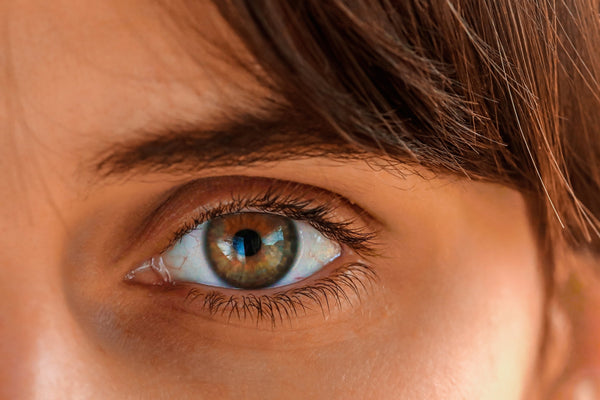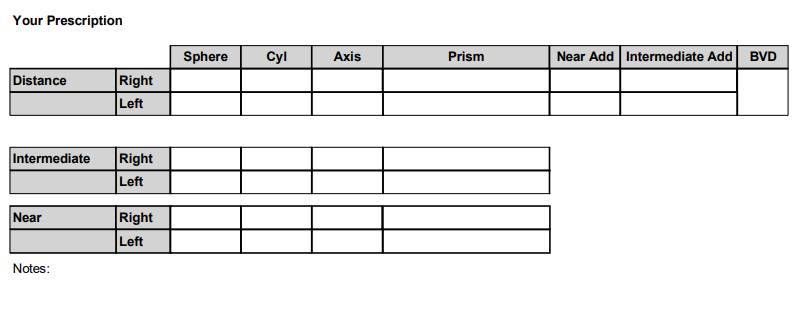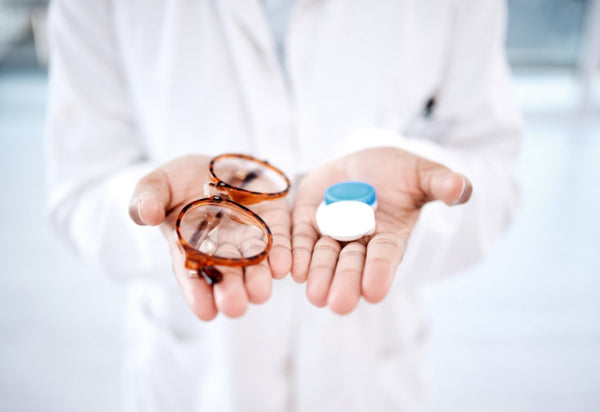
How to read your eye prescription
Regular eye check-ups are essential for healthy eyes and an accurate prescription. During an eye test, your vision and eye health are assessed, and you may be prescribed new glasses or an updated prescription.
A glasses prescription uses letters and numbers to show the type and strength of lenses you need. Glasses and contact lenses often require different prescriptions, so a separate test is needed if you want contacts. Read on to understand what the numbers and symbols on your prescription mean.
In order to read your prescription, you first need to understand what the various abbreviations and letters mean.

What do OD and OS mean?
When looking at your prescription, you may see the terms OD and OS. They explain which eye the prescription is for and are abbreviations for the Latin terms for your eyes:
- OD: stands for oculus dexter, or your right eye.
- OS: stands for oculus sinister, or your left eye
- OU or ODS: stands for oculus uterque/oculus dexter et sinister, or both eyes. OD refers to your right eye and OS refers to your left eye, as they often have different needs. When looking at the prescription, the left and right eyes are reversed to match your optometrist’s face-on view of your eyes.
What does SPH mean in my eye prescription?
SPH stands for sphere and is the amount of lens power you need for clear vision. It describes how long or short-sighted you are and is followed by a number, which is the unit used to measure the correction (dioptres). Usually, the further the number is from 0, the stronger the correction you need.
If you see a minus sign (-) before the numbers, this means you are short-sighted (myopic) – you can see things up close but objects further away can appear blurry. The higher the number after the minus, the more myopic you are.
Plus signs (+) mean you are long-sighted (hyperopic). You are likely to find seeing far away things easier than close up. The more long-sighted you are, the higher the number following the plus sign will be.
What does CYL mean in my eye prescription?
Standing for cylinder, CYL explains the amount of lens power needed to correct astigmatism – a condition where the eye doesn’t evenly focus. The CYL can be negative or positive. The higher the number, the stronger the astigmatism. If you don’t have astigmatism, or the effect is too small to need correction, you won’t have a CYL number on your prescription.
What does AXIS mean in my eye prescription?
AXIS and CYL work together to correct astigmatism. AXIS describes the orientation of the cylinder (astigmatic lens) required to correct your astigmatism. It’s displayed as a positive number between 0 and 180 degrees and acts almost like a map of your eye.
What does BASE mean in my eye prescription?
Some people have difficulty in eye coordination and require a special prismatic lens to help their eyes work together. The prismatic lens alters the direction of light travel without altering the focus. Prism stands for the amount of prism (in prism diopters) required, while base describes the orientation required for the prism to aid the eyes work together.
What does ADD mean in my eye prescription?
ADD describes the added lens power needed to make it easier for you to see at a closer range such as reading or using a computer. You will see this on a prescription for reading glasses or for the bottom part of varifocal lenses. The ADD number is usually the same for both eyes somewhere between +0.75 and +3.00 D.
What does BVD mean in my eye prescription?
BVD stands for back vertex distance. For higher prescriptions altering the position of the lens will alter its effect. In these cases the distance between the lens and surface of the eye is measured. This can be used to adapt the prescription should the desired spectacles sit at a different distance from the eye, maintaining equivalent focus.

What do '+' and '-' refer to on my prescription
If you see a minus sign (-) before the numbers, this means you are short-sighted (myopic) and there you can see things up close, but objects further away can appear blurry. The higher the number after the minus, the more myopic you are.
Plus signs (+) mean you are long-sighted (hyperopic). You are likely to find seeing far away things easier than close up. The more long-sighted you are, the higher the number following the plus sign will be.
Reading varifocal prescriptions
Varifocal prescriptions are designed to correct all distances in one lens, far, near, and everything in between. This is unlike regular single vision lenses, which only correct one distance. They will include an ADD for near vision and rely on an accurate pupillary distance (PD) so your eyes line up perfectly with each part of the lens, giving smooth, comfortable vision for everyday tasks.
How do I get a copy of my eye prescription?
You will be provided with a copy of your prescription after your eye test. This is for your reference and records but if you need a replacement copy for any reason, simply ask your optician and they’ll provide you one.








